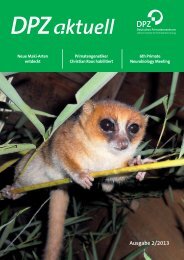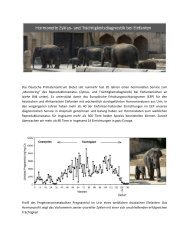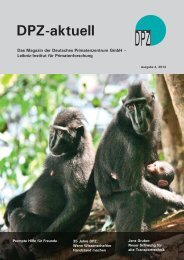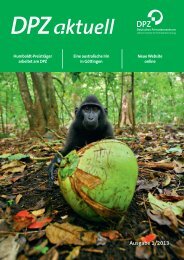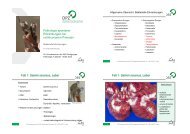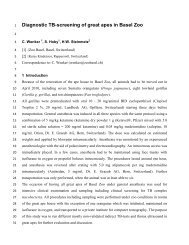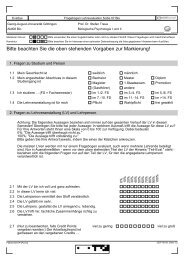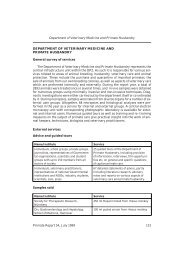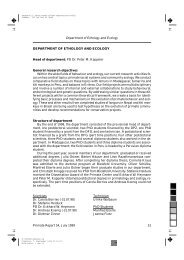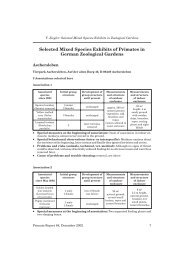Vol. 15 - Deutsches Primatenzentrum
Vol. 15 - Deutsches Primatenzentrum
Vol. 15 - Deutsches Primatenzentrum
You also want an ePaper? Increase the reach of your titles
YUMPU automatically turns print PDFs into web optimized ePapers that Google loves.
Lemur News <strong>Vol</strong>. <strong>15</strong>, 2010 Page 45<br />
58%<br />
(a) Dry season (b) Wet season<br />
9%<br />
2%<br />
1%<br />
30%<br />
25%<br />
11%<br />
6%<br />
1%<br />
Sifakas were highly folivorous during both seasons, supplementing<br />
their diet with flowers, fruits, vegetative buds, and<br />
sometimes young stems (Fig. 2). They consumed more mature<br />
leaves and fruits in the dry season and more flowers in<br />
the wet season.<br />
The activity budget of the sifakas is presented in Fig. 3. Although<br />
‘resting’ predominated throughout the study,<br />
individuals rested more in the dry season than in the wet season.Inversely,they<br />
travelled less and engaged in feeding activities<br />
more often during the wet season.<br />
Discussion<br />
The sifaka density was found to be high in the dry forest of<br />
Antrema, with a minimum estimate far above the 173 inds.<br />
km 2 found in the riparian forest of Anjamena (Muller et al.,<br />
2000) or for other sifaka species in dry or wet forests<br />
(O’Connor, 1988; Ganzhorn, 1992). This high density might<br />
be related to some peculiar characteristics of the forest in<br />
terms of food quantity and/or food quality available to this<br />
prosimian species. However,tree basal area was not particularly<br />
high compared with other dry forests in Madagascar<br />
and Mayotte (Hladik, 1980; Simmen et al., 2005). It is not yet<br />
clear also whether high density is related to a putative low<br />
predation pressure.To our knowledge,no sightings or traces<br />
of viverrid carnivores have been reported; large raptors and<br />
boas would be the only predators that could affect the<br />
demography of the Antrema sifaka population (Garbutt,<br />
2007; Sinclair and Legrand, 2008).<br />
As regards their feeding behavior, crowned sifakas fed primarily<br />
on leaves from a few tree, liana and vine species, and<br />
supplemented their diet with a wide range of secondary<br />
items as commonly occurs in other Propithecus species<br />
(Meyers and Wright, 1993; Simmen et al., 2003; Lehman and<br />
Mayor, 2004; Irwin, 2008). Although this species remained<br />
57% Young leaves<br />
Mature leaves<br />
Flowers<br />
Fruits<br />
Other<br />
Fig.2:Food categories in the diet of Propithecus coronatus during the dry season<br />
(a) and the wet season (b).<br />
29,4%<br />
(a) Dry season<br />
0,8% 5,9%<br />
50,0%<br />
(b) Wet season<br />
3,9%<br />
35,8%<br />
5,3%<br />
46,6%<br />
Resting<br />
Locomotion<br />
Foraging<br />
Feeding<br />
6,8%<br />
7,1%<br />
3,6% 4,8%<br />
Social<br />
Other<br />
Fig. 3: Activity budget of Propithecus coronatus during the dry season (a) and the<br />
wet season (b).<br />
folivorous during our study,its diet changed<br />
with seasons. Young leaves were the preferred<br />
food type in the early wet season,<br />
while mature leaves were the dominant one<br />
in the beginning of the dry season. In addition,<br />
P. coronatus ate a higher proportion of<br />
liana and vine parts during the wet season.<br />
Crowned sifakas also followed the typical<br />
activity pattern of other sifaka species<br />
(Norscia et al.,2006;Patel,2006;Charrier et<br />
al., 2007), spending most of their time resting<br />
and devoting a substantial amount of<br />
time to feeding activities and locomotion.<br />
Activity budget nevertheless changed with<br />
seasons. It is generally suggested that the<br />
cool dry season represents a period of food<br />
scarcity for animals,which they compensate<br />
for by reducing their energy expenditure,<br />
travelling less and resting more. In a recent<br />
joint research project, the content of litter<br />
traps regularly distributed along the transects<br />
was collected and weighted every two<br />
weeks throughout one year. It was found<br />
that plant species could be grouped according<br />
to their temporal pattern of leaf loss<br />
(Ranaivoson et al., 2010; see also Razakanirina,<br />
2010). Several trees, lianas and vines<br />
lost their leaves more or less regularly<br />
throughout the dry season while others<br />
were characterized by delayed leaf loss or<br />
on the contrary by precocious leaf fall.One<br />
consequence is that leaves are available<br />
throughout the year, although as different sets of species<br />
varying in quantity,diversity,and presumably,nutritional quality.This<br />
at least could explain why sifakas are able to increase<br />
the diversity of consumed plants (and adopt a more opportunistic<br />
strategy) during the dry season, a period normally<br />
described by the scarcity of food resources.<br />
Future work on seasonal variations in the diet’s nutritional<br />
and chemical content will allow us to examine the role of<br />
qualitative aspects in food choices (Moss,1991;Dearing et al.,<br />
2000) and further examine potential differences between<br />
genders with regard to the importance of energy conservation<br />
for female sifakas (Wright, 1999; Charrier et al., 2007).<br />
Conclusion<br />
Better knowledge of the ecology and the villagers’ social perception<br />
of this flagship species may contribute to conservation<br />
of other diurnal lemurs, by incorporating the villagers’<br />
symbolic perception of their natural environment. Investigating<br />
the interactions between this species and plants of the<br />
coastal dry forest ecosystem will undoubtedly result in<br />
better conservation decisions for Antrema. From an evolutionary<br />
ecology standpoint, the studies we have planned for<br />
the next years at Antrema will also contribute to better<br />
identify the selective pressures that have been driving the<br />
evolution of prosimian typical life-history traits such as<br />
reproductive synchronization or dominance-based feeding<br />
priority of females over males in gregarious species (Wright,<br />
1999; Dewar and Richard, 2007).<br />
Acknowledgements<br />
We thank the Malagasy Institutions that authorized to collect<br />
and export the plant samples,the Ministère de l’Environnement,<br />
des Eaux et forêts et du Tourisme. We also thank<br />
Antrema’s project staff for assistance with the field work as





